RBSE Solutions for Class 5 Maths Chapter 7 Equivalent Fractions
Rajasthan Board RBSE Solutions for Class 5 Maths Chapter 7 Equivalent Fractions Textbook Exercise Questions and Answers.
The questions presented in the RBSE Solutions for Class 5 Maths are solved in a detailed manner. Get the accurate RBSE Solutions for Class 5 all subjects will help students to have a deeper understanding of the concepts.
RBSE Class 5 Maths Solutions Chapter 7 Equivalent Fractions
Intext Questions:
Question 1.
Represent the equivalent fractions by filling colour in the following diagrams.
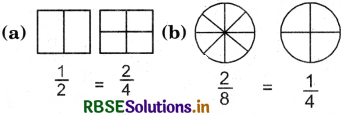
Solution:

Question 2.
Can we convert a fraction into equivalent fraction by multiplying numerator and denominator with the same number.
Solution:
Yes we can.
For example:
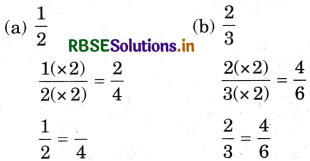

Question 3.
Can we also convert a fraction into equivalent fraction by dividing numerator and denominator with the same number?
Solution:
Yes, we can.
For example (a) \(\frac{6}{9}\), (b) \(\frac{2}{4}\)
(a) \(\frac{6}{9}=\frac{6 \div 3}{9 \div 3}=\frac{2}{3}\)

(b) \(\frac{2}{4}=\frac{2 \div 2}{4 \div 2}=\frac{1}{2}\)
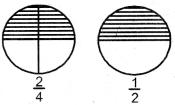

Exercise:
Question 1.
Convert the given fraction into equivalent fraction by multiplying numerator and denominator by 2.
Solution:
(i) \(\frac{1}{2}\)
(ii) \(\frac{2}{3}\)
(iii) \(\frac{1}{5}\)
(iv) \(\frac{2}{5}\)
(v) \(\frac{2}{7}\)
Solution:
(i) \(\frac{1}{2}=\frac{1 \times 2}{2 \times 2}=\frac{2}{4}\)
(ii) \(\frac{2}{3}=\frac{2 \times 2}{3 \times 2}=\frac{4}{6}\)
(iii) \(\frac{1}{5}=\frac{1 \times 2}{5 \times 2}=\frac{2}{10}\)
(iv) \(\frac{2}{5}=\frac{2 \times 2}{2 \times 5}=\frac{4}{10}\)
(v) \(\frac{2}{7}=\frac{2 \times 2}{7 \times 2}=\frac{4}{14}\)

Question 2.
Convert the given fraction into equivalent fraction by multiplying numerator and denominator by 3.
(i) \(\frac{1}{4}\)
(ii) \(\frac{3}{5}\)
(iii) \(\frac{2}{5}\)
(iv) \(\frac{2}{7}\)
(v) \(\frac{1}{6}\)
Solution:
(i) \(\frac{1}{4}=\frac{1 \times 3}{4 \times 3}=\frac{3}{12}\)
(ii) \(\frac{3}{5}=\frac{3 \times 3}{5 \times 3}=\frac{9}{15}\)
(iii) \(\frac{2}{5}=\frac{2 \times 3}{5 \times 3}=\frac{6}{15}\)
(iv) \(\frac{2}{7}=\frac{2 \times 3}{7 \times 3}=\frac{6}{21}\)
(v) \(\frac{1}{6}=\frac{1 \times 3}{6 \times 3}=\frac{3}{18}\)
Question 3.
Convert the given fraction into equivalent fraction by multiplying numerator and denominator by 2, 3 and 4 respectively.
(i) \(\frac{1}{4}\)
(ii) \(\frac{2}{3}\)
(iii) \(\frac{2}{5}\)
(iv) \(\frac{3}{4}\)
Solution:
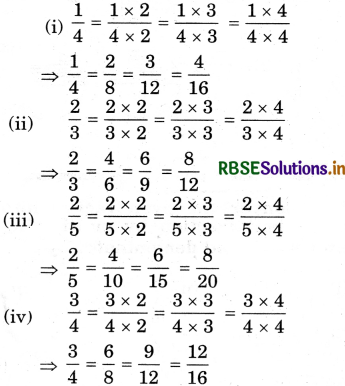

Question 4.
Represent the given equivalent fractions by filling colour in following diagrams.
(i) 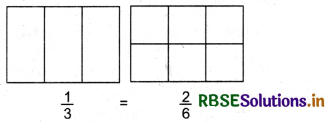
(ii) 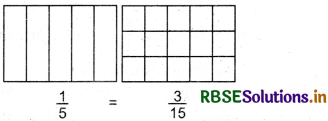
Solutions:
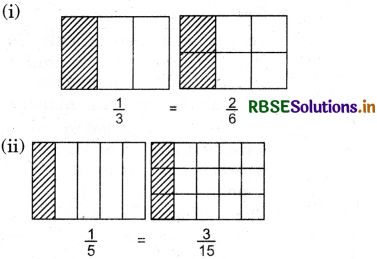

Question 5.
Fill in the blanks:
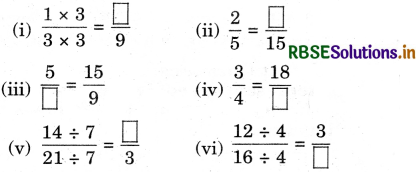
Solution:
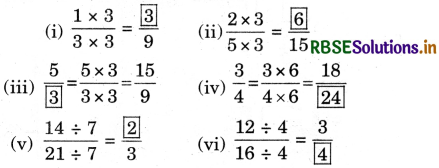

Question 6.
Given some examples where we get after dividing equally and write down below.
\(\frac{1}{4}=\frac{2}{8}=\frac{3}{12}\) = .................
Solution:
\(\frac{1}{4}=\frac{2}{8}=\frac{3}{12}=\frac{4}{16}=\frac{5}{20}\) = \(\frac{6}{24}=\frac{7}{28}=\frac{8}{32}\)
Question 7.
Write four equivalent fractions of .
Solution:
\(\frac{1}{5}=\frac{1 \times 2}{5 \times 2}=\frac{1 \times 3}{5 \times 3}=\frac{1 \times 4}{5 \times 4}=\frac{1 \times 5}{5 \times 5}\)
⇒ \(\frac{1}{5}=\frac{2}{10}=\frac{3}{15}=\frac{4}{20}=\frac{5}{25}\)

Question 8.
Ranu bought 6 meter long ribbon from market, if she equally divides it among 4 friends, then what is the length of ribbon each friend will get?
Solution:
Each friend (out of 4) will get m. ribbon.
\(\frac{6}{4}=1+\frac{2}{4}\) i.e., 1\(\frac{1}{2}\)
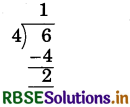
∴ Each will get 1 m ribbon.
Question 9.
Saraswati needs 1 meter of cloth to make a shirt. How much cloth she needs to make two such shirts?
Solution.
Closth required for 1 shirt = 1\(\frac{1}{4}\) m
Cloth required for 2 shirts = (1\(\frac{1}{4}\) + 1\(\frac{1}{4}\))
= (1 + \(\frac{1}{4}\) + 1 + \(\frac{1}{4}\))
= (1 + 1 + \(\frac{1}{4}\) + \(\frac{1}{4}\))
= (2 + \(\frac{2}{4}\))
= (2 + \(\frac{1}{2}\))
= 2\(\frac{1}{2}\) m
Thus, 2\(\frac{1}{2}\) m cloth is required for 2 shirts.

Important Questions:
Multiple Choice Questions:
Question 1.
If 20 litre milk is distributed in 5 houses, then numerator of simplest form of obtained fraction will be :
(a) 4
(b) 5
(c) 6
(d) 7
Solution:
(a) 4
Question 2.
Simplest form of \(\frac{35}{5}\) is :
(a) 4
(b) 5
(c) 6
(d) 7
Solution:
(d) 7
Question 3.
Solving 43 ÷ 3, remainder will be :
(a) 0
(b) 1
(c) 2
(d) 3
Solution:
(b) 1

Question 4.
2 litre kerosine is filled in one stove, then kerosine filled in 5 stoves will be :
(a) 8
(b) 9
(c) 10
(d) 12
Solution:
(c) 10
Question 5.
If 5 chapatis are distributed between 2 children, each will get:
(a) 2\(\frac{1}{2}\)
(b) 1\(\frac{1}{2}\)
(c) 2
(d) 1
Solution:
(a) 2
Question 6.
\(\frac{2}{5}\) will be equivalent to:
(a) \(\frac{4}{10}\)
(b) \(\frac{6}{10}\)
(c) \(\frac{8}{10}\)
(d) \(\frac{10}{20}\)
Solution:
(a) \(\frac{4}{10}\)

Question 7.
\(\frac{3 \times 5}{5 \times 5}=\frac{\square}{25}\), empty box will have:
(a) 5
(b) 10
(c) 15
(d) 20
Solution:
(c) 15
Question 8.
Equivalent fraction of \(\frac{3}{4}\) is :
(a) 8/16
(b) 12/16
(c) 8/12
(d) None of these
Solution:
(b) 12/16

Short Answer Type Questions:
Question 1.
Write three equivalent fraction of .
Solution:
\(\frac{2}{3} \times \frac{2}{2}=\frac{4}{6}\)
\(\frac{2}{3} \times \frac{3}{3}=\frac{6}{9}\)
\(\frac{2}{3} \times \frac{4}{4}=\frac{8}{12}\)
Thus, three equivalent fractions of \(\frac{2}{3}\) are \(\frac{4}{6}\), \(\frac{6}{9}\) and \(\frac{8}{12}\).
Question 2.
15 litre kerosine has to fill equally in 3 stoves. How much kerosine will be filled in each stove?
Solution:
∵ Total kerosine = 15 l and number of stoves to be filled with kerosine = 3
Kerosine will be filled in each stove = (15 ÷ 3) = 5
Thus, each stove will be filled with 5 l kerosine.
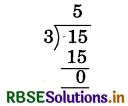

Question 3.
10 litre milk is distributed among 20 children, then how much milk each child got?
Solution:
∵ Total milk = 10 l
Number of children = 20
Each child will get milk = (10 ÷ 20) = \(\frac{10}{20}=\frac{1}{2}\) l
Thus, each child got \(\frac{1}{2}\) l milk.
Question 4.
If 20 chapati are distributed among 5 kids. Then how many chapati got by each one :
Solution:
Total number of chapati = 20
Total number of kids = 5
⇒ Each kid get chapati = (20 ÷ 5) = \(\frac{20}{5}\) = 4 chapati
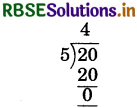
So, each kids got 4 chapati.

Question 5.
A packet contains 5 candles then find how many prockets will be formed by 729 candles and how many candles will be left ?
Solution:
∵ Total candles = 729
∴ packet contains 5 candles,number of packets = 729 ÷ 5
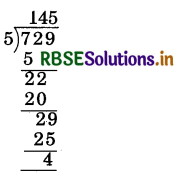
Number of packets So, 145 packets will be formed and 4 candles will be left.

Question 6.
Sita bought 1\(\frac{1}{2}\) l milk. Her sister bought 2\(\frac{1}{2}\) l milk. How much milk will be collected in house. It rate of 1 l milk is ₹ 30, then how much money Sita and her sister spend separately?
Solution:
∵ 1 l = 1000 ml
∴ \(\frac{1}{2}\) l = 500 ml
Sita bought milk = 1 \(\frac{1}{2}\) l {1l 500 ml)
Her sister bought milk = 2 \(\frac{1}{2}\) (2l 500 ml)
Total milk bought milk = 1 l 500 ml + 2 l 500 l = l
Cost of 1l litre milk = ₹ 30
Cost of \(\frac{1}{2}\) l milk = \(\frac{30}{2}\) = ₹ 15
Sita has spent on 1\(\frac{1}{2}\) l milk (30 + 15)= ₹ 45
Her sister spent on 2\(\frac{1}{2}\)l milk = ₹ (30 + 30 + 15) = ₹ 75

- RBSE Solutions for Class 5 Maths Chapter 11 Time
- RBSE Solutions for Class 5 Maths Chapter 17 मन गणित
- RBSE Solutions for Class 5 Maths in Hindi Medium & English Medium
- RBSE Solutions for Class 5 Maths Chapter 16 ज्यामिती
- RBSE Solutions for Class 5 Maths Chapter 15 धारिता
- RBSE Solutions for Class 5 Maths Chapter 14 परिमाप एवं क्षेत्रफल
- RBSE Solutions for Class 5 Maths Chapter 13 मापन (लंबाई)
- RBSE Solutions for Class 5 Maths Chapter 12 भार
- RBSE Solutions for Class 5 Maths Chapter 11 समय
- RBSE Solutions for Class 5 Maths Chapter 10 मुद्रा
- RBSE Solutions for Class 5 Maths Chapter 9 आँकड़े